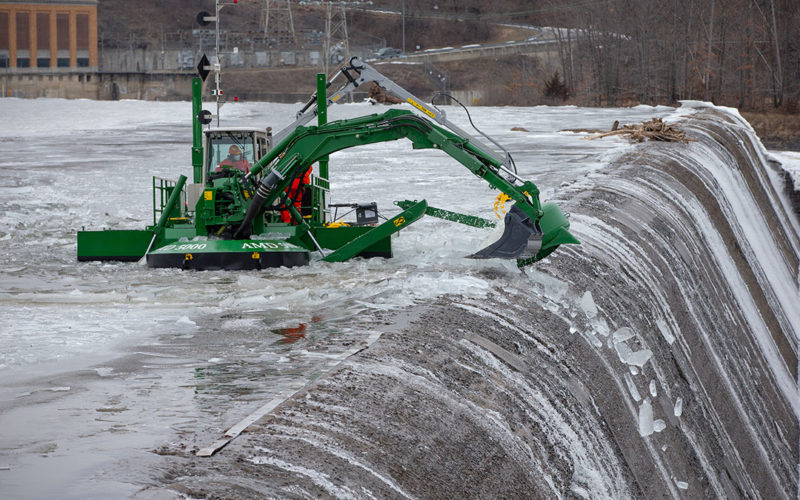Far too often, Erie Canal communities have been threatened by flooding in the spring due to the formation of ice jams. Tugboats might not be a solution most people would consider to mitigate the problem, but New York’s Reimagine the Canals program is now utilizing a tug to break up sheet ice along the route shared by the canal and the Mohawk River. The goal is to preserve a historic canal-side landmark area.
[gtx_gallery]
Mild weather early last winter in the Mohawk River region was good news for the low-lying Stockade District in Schenectady, N.Y. The architecture and streetscapes in the Stockade make up one of the oldest continuously settled neighborhoods in the country. First settled in 1661 by Dutch merchants and fur traders and inhabited ever since, the 82-acre zone has “the highest concentration of historic period homes in the country, with over 40 houses more than 200 years old,” according to the National Park Service. Of the 380 buildings in the neighborhood, two are listed on the National Register of Historic Places.
In recent years, the Stockade has flooded when the weather warms quickly in the spring. Mohawk River ice, sometimes up to 12 inches thick, breaks up and causes ice jams downstream, forcing the water to rise. The flooding has disrupted the lives of residents and resulted in huge insurance claims for increasingly fragile structures.
Enter the tugboats stationed above the 30-foot-high Vischer Ferry hydroelectric dam and the adjacent Erie Canal Lock 7. The 85-foot Margot, part of the New York State Marine Highway fleet, serves as the icebreaker, with the 48-foot Benjamin Elliot providing emergency backup in case Margot becomes disabled in the ice. That is not a likely scenario, but if it did happen, the rescue would be complicated because the canalized Mohawk River is closed each winter for maintenance and upgrades.
Margot was built in 1958 by Jakobson Shipyard in Oyster Bay, N.Y., originally carrying the moniker Hustler II for the Oil Transfer Corp. The tug changed hands several times over the years and was acquired by the New York State Marine Highway Transportation Co. in 2002. The single-screw veteran is powered by a 1,440-hp Fairbanks Morse diesel engine.
When temperatures plummeted in the region in mid-January and stayed below freezing, ice built up behind the dam and Margot began its mitigation work. Icebreaking above the dam allows ice to freely flow through upstream constrictions, reducing the chance of ice jam formation. The tug works to prevent ice from becoming more than 12 inches thick, as well as to move it over the dam when warm temperatures create the potential for ice sheet movement.
Stationing a tugboat above the dam to break up ice was an idea generated by Reimagine the Canals. The New York Power Authority and New York State Canal Corp. (NYS Canals) launched the flood mitigation effort in partnership with a collection of private, state and federal entities: Clarkson University, Union College, the New York State Department of Environmental Conservation, the U.S. Geological Survey (USGS), the National Weather Service, and the U.S. Army Corps of Engineers.
In addition to using Margot, NYS Canals has acquired a Watermaster, a 36-foot amphibious multipurpose machine. Multipurpose in this case means it can break ice in winter and dredge during the summer. Unlike a tugboat, the operator of the Watermaster does not need to have a U.S. Coast Guard captain’s license.
NYS Canals is also becoming more proactive when it comes to monitoring ice jams. Partnering with the USGS, the agency is developing a model to predict ice jam formation, which will be part of the warning system that alerts canal-side residents of an impending threat. Installing pneumatically operated crest gates along the top of the Vischer Ferry dam is another mitigation option being studied.
Flooding in the Mohawk Valley occurs at other times of the year as well, as in 2011 in the wake of Hurricane Irene and Tropical Storm Lee. Apart from the current icebreaking initiative, the Federal Emergency Management Agency granted the city of Schenectady $8.6 million in 2018 to study options and implement solutions.
New York Gov. Andrew Cuomo called the 2021 icebreaking operation “a pilot program to understand the effectiveness of the icebreaking tugs.” He said the state would be continuously evaluating its efforts “and will look to incorporate lessons learned from this pilot into future resiliency planning efforts and operations.”
The Reimagine the Canals initiative utilizes 21st-century technology to protect one of New York’s most valuable 17th- and 18th-century heritage sites. The function of the canal system may have changed in the past century, but the value of the Erie Canal and the canal-side Schenectady community cannot be understated — two landmarks adding priceless value to the state. •

